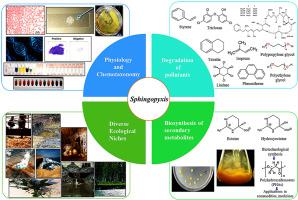Journal of Environmental Management ( IF 8.0 ) Pub Date : 2020-12-03 , DOI: 10.1016/j.jenvman.2020.111744 Monika Sharma , Himani Khurana , Durgesh Narain Singh , Ram Krishan Negi

|
The genus Sphingopyxis was first reported in the year 2001. Phylogenetically, Sphingopyxis is well delineated from other genera Sphingobium, Sphingomonas and Novosphingobium of sphingomonads group, family Sphingomonadaceae of Proteobacteria. To date (at the time of writing), the genus Sphingopyxis comprises of twenty validly published species available in List of Prokaryotic Names with Standing in Nomenclature. Sphingopyxis spp. have been isolated from diverse niches including, agricultural soil, marine and fresh water, caves, activated sludge, thermal spring, oil and pesticide contaminated soil, and heavy metal contaminated sites. Sphingopyxis species have drawn considerable attention not only for their ability to survive under extreme environments, but also for their potential to degrade number of xenobiotics and other environmental contaminants that impose serious threat to human health. At present, genome sequence of both cultivable and non-cultivable strains (metagenome assembled genome) are available in the public databases (NCBI) and genome wide studies confirms the presence of mobile genetic elements and plethora of degradation genes and pathways making them a potential candidate for bioremediation. Beside genome wide predictions there are number of experimental evidences confirm the degradation potential of bacteria belonging to genus Sphingopyxis and also the production of different secondary metabolites that help them interact and survive in their ecological niches. This review provides detailed information on ecology, general characteristic and the significant implications of Sphingopyxis species in environmental management along with the bio-synthetic potential.
中文翻译:

Sphingopyxis属:系统学,生态学和生物修复潜力-审查
Sphingopyxis属是在2001年首次报道的。从系统发育上讲,Sphingopyxis与sphingomonads属,Proteobacteria家族的Sphingomonads组的其他Sphingobium,Sphingomonas和Novosphingobium属相近。迄今为止(在撰写本文时),Sphingopyxis属由二十种有效出版的物种组成,这些物种可在具有命名法的原核生物名称列表中获得。鞘氨醇spp。已从各种生态位中分离出来,这些生态位包括农业土壤,海水和淡水,洞穴,活性污泥,温泉,石油和农药污染的土壤以及重金属污染的地点。鞘氨醇该物种不仅受到其在极端环境下生存的能力的关注,而且还因其降解大量对人类健康构成严重威胁的异种生物和其他环境污染物的潜力而受到了广泛关注。目前,可在公共数据库(NCBI)中获得可培养和不可培养菌株的基因组序列(由基因组组装的基因组),并且全基因组研究证实了可移动遗传元件的存在以及大量降解基因和途径,使其成为潜在的候选基因用于生物修复。除了全基因组预测外,还有大量实验证据证实了狮身人面菌属细菌的降解潜力。以及各种次生代谢产物的产生,这些代谢产物可帮助它们在生态环境中相互作用并生存。这篇综述提供了有关生态,一般特征和狮身鱼属物种在环境管理中的重要信息以及生物合成潜力的详细信息。











































 京公网安备 11010802027423号
京公网安备 11010802027423号